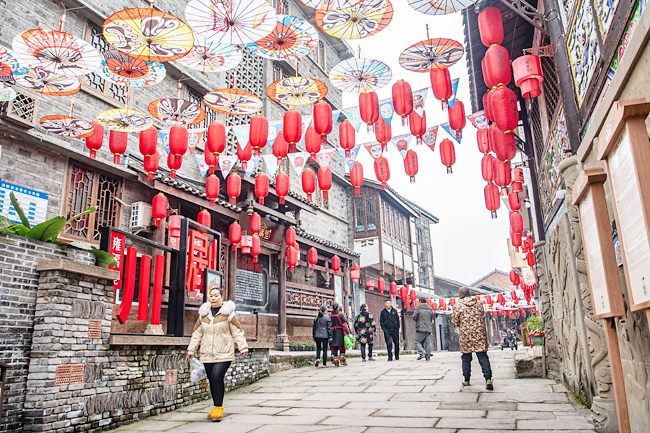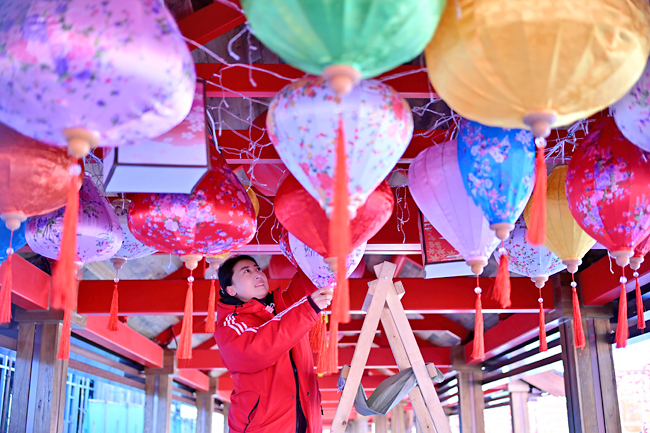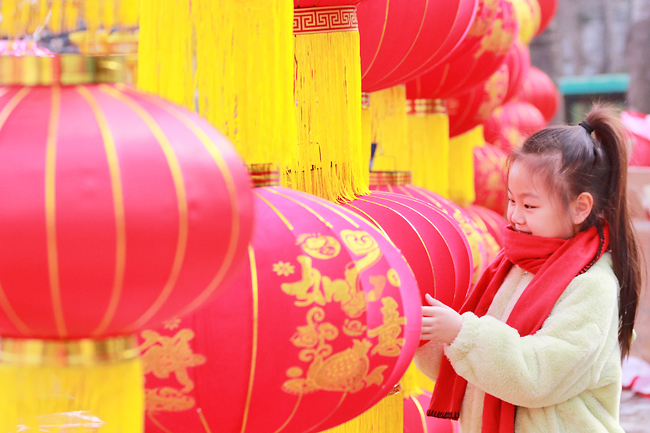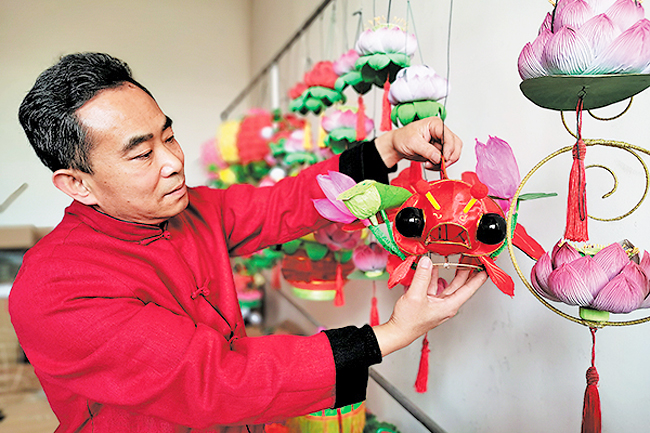ANN/CHINA DAILY – Lanterns persist in illuminating the rich tapestry of Chinese cultural tradition, embodying their significance in more ways than one.
Beyond their literal function of dispelling darkness during the night, these ancient art forms serve as beacons that prevent the fading of culture into obscurity over time. They not only brighten physical surroundings but also evoke joy and nostalgia among the Chinese populace.
Internationally, these lanterns stand as iconic symbols of the country’s heritage.
Dating back to the Western Han Dynasty (206 BC-AD 24), ordinary people have delighted in the luminous spectacle of festive celebrations brought to life by these timeless lanterns.
Then, the greater social harmony and economic prosperity of the Tang Dynasty (618-907) propelled their popularity to a peak, and Lantern Festival became an annual milestone event on the 15th day of the first lunar month.
Numerous ancient poems recount emotional scenes in which various shapes and sizes of bright lanterns are crafted to light up bustling scenes enjoyed amid prosperity.
This heightened sense of lantern appreciation persisted into the Ming (1368-1644) and Qing (1644-1911) dynasties, marked by the emergence of lantern markets that fostered growing numbers of designs.





Today, such large-scale events as the Qinhuai lantern fair in Jiangsu’s provincial capital, Nanjing, and the Zigong lantern festival in Sichuan province captivate much attention.
Time and place have, indeed, literally shaped these handicrafts, which have come to bear increasingly distinctive regional characteristics from their conception to completion.
Zhai Yuliang becomes extra busy whenever the holidays are around the corner, starting with New Year’s Day.
The Beijinger, who’s in his 60s, has just finished a pair of “palace lanterns “for a courtyard home in the capital.
“The owner wants every part of them to be done the old-fashioned way, so that they will fit perfectly with the majestic style of their historical house,” said Zhai, who has practiced for more than four decades the craft that was listed as a national-level intangible cultural heritage in 2008.
BRILLIANT ORIGINS
One of the most popular styles, which is also Zhai’s favourite, is the double-layered hexagonal palace lantern that features arched spines, dragon heads, eaves, pillars and windows.
“It’s full of Chinese elements, and has maintained typical models and structures for thousands of years,” he said.
Yet, palace lanterns could also feature many other specific motifs for particular events. Birthday celebrations in the palace, for instance, involved lanterns that featured images of flowers and peaches to convey wishes for longevity.
Zhai considered the hexagonal shape to be the best, since it can serve as the basis for a variety of designs.
“The hexagonal lantern is double layered, but I can alter it to have four or six or even eight layers,” he explained, pointing out that additional layers can be added around the core to create a more complex and intricate visual appeal.
Zhai entered the trade immediately after finishing middle school, when he took an apprenticeship at a lantern factory in Beijing in 1975, under masters who used to make lanterns for the royal family.
“One of them would usually get instructions from the (imperial court) management officials, who asked him to make certain lanterns for certain places, regardless of the costs in terms of time and materials,” Zhai recalled.
“The palace lanterns were initially primarily used for decoration, with illumination as a secondary purpose, and since they were exclusively for the imperial court, they all exuded a royal grandeur,” Zhai said.
It wasn’t until China’s final dynasty, the Qing, that the emperors began to bestow palace lanterns on officials as rewards. Gradually, they started becoming more common among commoners, and, by the end of imperial China, they had become part of most ordinary people’s lives.
“For festivals, folks (in Beijing) started making (palace) lantern frames from materials like bamboo and sorghum, on which they pasted paper-cuts,” Zhai said.
Production soon expanded to include other places like Shanghai, Guangzhou in Guangdong province and Hebei province.
“They’ve retained their general shapes as they’ve spread over time, but you’ll notice some differences in the feel if you look closely,” Zhai said.
“In the south, for instance, they tend to be more delicately and intricately carved, while in the north, and especially in Beijing, they are grander and more solemn.” However, he stressed, they must retain the essence to be classified as palace lanterns – that is, they must comprise a wooden frame with panels featuring painted scenes and traditional tassels or Chinese knots as adornment.
Most importantly, they must be created using the specified production techniques, which require over 100 steps, including wood preparation, carving, assembling, gluing, painting, attaching dragon heads and hanging tassels.
In the old days, a single craftsman had to do everything from the woodwork to painting.
“Sometimes, it took several months to make a palace lantern,” Zhai said.
The favoured wood varieties are rosewood and sandalwood from Guangdong and Guangxi Zhuang autonomous region, since they have a fine, hard texture and lack pores, he said.
A thin iron wire tied to both tips of a bow is used as a saw to cut delicate patterns, like dragon heads, out of the wooden boards, before further carving with a knife followed
by polishing.
Craftspeople sometimes cut two or three boards with the same pattern at the same time to increase efficiency.
“That really tests your skills because a novice might do well with the top board but ruin the bottom board,” he said.
“It took me three years to learn how to do the woodwork.”
Palace lanterns are always built using mortise-and-tenon joints. The frame has to be well-designed to ensure it’s sturdy since no nails are used.
Hollowed-out decorative patterns are carved into the completed frame. The protruding parts of the notches are called “flower teeth” and are rendered in dozens of styles with many variations. “Most carvings’ locations are flexible, but dragon and phoenix heads must be placed atop the pillars,” Zhai said. The pane also needs to be covered with silk that’s painted with images before it’s pasted on the glass.
Palace lantern craftspeople need the skills of a carpenter, the knowledge of a mechanic, an appreciation of classical architecture, a proficiency in poetry and painting, and an additional talent for fashioning mortises and tenons before they can create the right carvings and layer combinations, he said.
REGIONAL REVIVALS
In Shengfang town, Hebei’s Langfang city, Niu Junqi has just finished a massive set of Shengfang-style lanterns for the Qinhuai lantern fair that will open in early February.
His work features a circular pool that’s six metres in diameter with a leaping carp in the centre, surrounded by lotus flowers and leaves. “It represents the prosperity and charm of a northern water town,” said Niu, whose family has created lanterns in this town for four generations. The lanterns from his hometown have evolved to absorb elements of local life, customs and environs that contrast them with Beijing’s palace lanterns.
There are about 20 major varieties, the most distinctive of which feature motifs of water towns or are actually children’s toys that resemble ducks, watermelons, cars, goldfish and mythical figures, he added.
Shengfang lanterns also made the national-level intangible cultural heritage list in 2008.
Chinese lanterns have been shining brighter overseas, too, as more lantern festivals are held abroad, attracting not only people of Chinese ancestry but other visitors, too.
Li Yuanyuan, who’s an experienced curator of exhibitions of Chinese intangible cultural heritage, said, “These kinds of lanterns embody the unique beauty of light as expressed by Chinese people. They have witnessed our civilisation’s evolution and illuminated its development path. They’re one of the oldest household items and once were among the most intimate daily necessities used by all people. So, they carry cultural history and cohesion.”
She believed they showcase artisans’ ingenuity across dynasties, as they refined gold and jade to likewise make bamboo and wood radiate. The approach of Spring Festival means Zhai has received many invitations from communities and institutes to showcase palace lanterns’ charm.
He particularly enjoys hosting workshops where he teaches people to make lanterns themselves. He delights in the proud smiles of children and the nostalgic expressions of adults, when they complete their works under his guidance.
Technology has made it easier to craft lanterns, but Zhai contends it’s essential to keep the handiwork traditions alive.
“Take adhering the cloth to the glass, for example – you have to do it by hand to ensure the fabric is smooth, without pleats, when it’s applied atop curved surfaces. You can’t do it with a sewing machine.”
The demanding character of the techniques means the number of inheritors has waned to the point where the few remaining masters are elderly.
“We need to promote and popularise it, so that more people can understand palace lanterns and their cultural significance,” Zhai said.
He believed his lifelong devotion to this craft has been worthwhile. His octagonal lanterns can be seen in such locations as the Tian’anmen Rostrum and many overseas sites that foster friendship with China.
“Wherever you are, when you see a palace lantern, you know there’s a connection to China,” Zhai said. – Yang Feiyue







